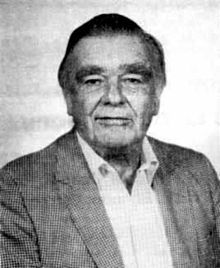Roger Lyndon
Roger Conant Lyndon (born December 18, 1917 in Calais , Maine , † June 8, 1988 in Ann Arbor , Michigan ) was an American mathematician .
Roger Lyndon studied literature and then mathematics at Harvard University with a bachelor's degree in 1939, where he obtained his master's degree in 1941 after a brief interim period as a bank clerk . He taught briefly at the Georgia Institute of Technology and from 1942 helped Harvard in the training of members of the Navy during World War II. In 1946 he received his doctorate from Harvard with Saunders Mac Lane (dissertation The Cohomology Theory of Group Extensions ). Then he was at the Office of Naval Research , was an assistant professor at Princeton University and from 1953 at the University of Michigan , where he became a professor.
In his doctoral thesis he dealt with group cohomology and it was his contribution to the Lyndon-Hochschild-Serre spectral sequence (it connects the cohomology of the group with that of its normal divisors and their factor groups ). Curtis, Hedlund and Lyndon's theorem plays a fundamental role in symbolic dynamics and in cellular automata (also named after Morton L. Curtis and Gustav Hedlund ). It says that morphisms between shift spaces are precisely given by cellular automata. In formal logic, Craig and Lyndon's interpolation theorem is named after him (1959) and William Craig (1957). In addition, the Lyndon word is named after him.
With his PhD student Paul Schupp he wrote a standard work on combinatorial group theory . His other PhD students include Kenneth Appel and Joseph Kruskal .
Fonts
- with Paul Schupp: Combinatorial Group Theory, Springer 1977, reprint in the Classics in Mathematics 2001 series, ISBN 978-3-642-61896-3
- Notes on Logic, Van Nostrand, 1967
- Editor with WW Boone, FB Cannonito: Word Problems: Decision Problem in Group Theory, North-Holland, 1973
- Groups and Geometry, Cambridge University Press, 1985, ISBN 978-0-521-31694-1
Web links
- John J. O'Connor, Edmund F. Robertson : Roger Lyndon. In: MacTutor History of Mathematics archive .
Individual evidence
- ↑ Roger Lyndon in the Mathematics Genealogy Project (English)
- ↑ Hedlund, Endomorphisms and Automorphisms of the Shift Dynamical Systems, Mathematical System Theory, Volume 3, 1969, pp. 320-375, Hedlund names Curtis and Lyndon as co-discoverers
| personal data | |
|---|---|
| SURNAME | Lyndon, Roger |
| ALTERNATIVE NAMES | Lyndon, Roger Conant (full name) |
| BRIEF DESCRIPTION | American mathematician |
| DATE OF BIRTH | December 18, 1917 |
| PLACE OF BIRTH | Calais , Maine |
| DATE OF DEATH | June 8, 1988 |
| Place of death | Ann Arbor , Michigan |
